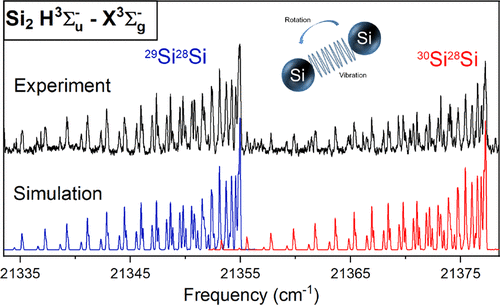当前位置:
X-MOL 学术
›
J. Phys. Chem. A
›
论文详情
Our official English website, www.x-mol.net, welcomes your feedback! (Note: you will need to create a separate account there.)
High-Resolution Laser Spectroscopic Survey of the H3Σu––X3Σg– Electronic Transition of Si2
The Journal of Physical Chemistry A ( IF 2.9 ) Pub Date : 2020-04-02 , DOI: 10.1021/acs.jpca.0c00370 Boxing Zhu 1 , Jingwang Gu 1 , Chunting Yu 1 , Zengjun Xiao 1 , Yang Chen 1 , Dongfeng Zhao 1
The Journal of Physical Chemistry A ( IF 2.9 ) Pub Date : 2020-04-02 , DOI: 10.1021/acs.jpca.0c00370 Boxing Zhu 1 , Jingwang Gu 1 , Chunting Yu 1 , Zengjun Xiao 1 , Yang Chen 1 , Dongfeng Zhao 1
Affiliation

|
Rotationally resolved spectra of the H3Σu––X3Σg– electronic transition bands of Si2 have been experimentally studied using laser-induced fluorescence in the 380–520 nm range. Si2 molecules are produced in a supersonically expanding planar plasma by discharging a silane/argon gas mixture. In total, 44 bands belonging to the H3Σu––X3Σg– electronic transition system of the most abundant isotopologue 28Si2 are experimentally recorded. With a spectral resolution of ∼0.04 cm–1, the triplet spin-splitting structures in individual rotational transition lines are fully resolved. Detailed analyses on the high-resolution spectra have yielded an accurate determination of spectroscopic constants for both X3Σg– and H3Σu– states. The spin–spin interaction constants for the two triplet states are found to be comparable (λ ≈1.5 cm–1), which may originate from the 3p atomic orbital interaction in the triplet Si2 molecule. The measured isotopologue spectra of 29Si28Si and 30Si28Si indicate that the H3Σu––X3Σg– transition system of 29S28S and 30S28S can be reasonably reproduced by the isotope mass-scaling rule. Spectroscopic parameters, including the Franck–Condon factors, the Einstein coefficients, and the oscillator strengths, are also determined from the experimental results and the Rydberg–Klein–Rees (RKR) calculations. The agreement between the experimentally measured and calculated dispersed fluorescence spectra indicates that the RKR calculations with the molecular constants determined in this work can accurately reproduce the diatomic potentials of both states. These molecular data provide a benchmark in high-level theoretical studies on Si2 and likely other small silicon clusters.
中文翻译:

在H的高分辨率激光光谱测量3 Σ Ü - -X 3 Σ克-电子跃迁的Si 2
旋转地分辨的光谱为H 3 Σ Ü - -X 3 Σ克-硅的电子过渡频带2已经在380-520 nm范围内使用激光诱导荧光了实验研究。通过排出硅烷/氩气混合物,在超音速扩展的平面等离子体中产生Si 2分子。总体而言,属于H 44个带3 Σ Ü - -X 3 Σ克-电子跃迁的最丰富的同位素的系统28的Si 2是通过实验记录。光谱分辨率约为0.04厘米–1,完全分解了单个旋转过渡线上的三重态自旋分裂结构。在高分辨率的详细分析光谱已经产生了光谱常数的精确确定两个X 3 Σ克-和H 3 Σ Ú -状态。发现两个三重态的自旋-自旋相互作用常数是可比较的(λ≈1.5cm –1),这可能源自三重态Si 2分子中的3p原子轨道相互作用。测得的29 Si 28 Si和30 Si 28 Si的同位素谱表明,H 3Σ ü - -X 3 Σ克-过渡的系统29小号28 S和30 S ^ 28可以通过同位素质量换算规则合理地再现S。光谱参数,包括弗兰克-康登因子,爱因斯坦系数和振荡器强度,也从实验结果和里德伯格-克莱因-里斯(RKR)计算中确定。实验测量和计算的分散荧光光谱之间的一致性表明,在这项工作中确定的具有分子常数的RKR计算可以准确地再现这两种状态的双原子电势。这些分子数据为有关Si 2和可能的其他小硅簇的高级理论研究提供了基准。
更新日期:2020-04-03
中文翻译:

在H的高分辨率激光光谱测量3 Σ Ü - -X 3 Σ克-电子跃迁的Si 2
旋转地分辨的光谱为H 3 Σ Ü - -X 3 Σ克-硅的电子过渡频带2已经在380-520 nm范围内使用激光诱导荧光了实验研究。通过排出硅烷/氩气混合物,在超音速扩展的平面等离子体中产生Si 2分子。总体而言,属于H 44个带3 Σ Ü - -X 3 Σ克-电子跃迁的最丰富的同位素的系统28的Si 2是通过实验记录。光谱分辨率约为0.04厘米–1,完全分解了单个旋转过渡线上的三重态自旋分裂结构。在高分辨率的详细分析光谱已经产生了光谱常数的精确确定两个X 3 Σ克-和H 3 Σ Ú -状态。发现两个三重态的自旋-自旋相互作用常数是可比较的(λ≈1.5cm –1),这可能源自三重态Si 2分子中的3p原子轨道相互作用。测得的29 Si 28 Si和30 Si 28 Si的同位素谱表明,H 3Σ ü - -X 3 Σ克-过渡的系统29小号28 S和30 S ^ 28可以通过同位素质量换算规则合理地再现S。光谱参数,包括弗兰克-康登因子,爱因斯坦系数和振荡器强度,也从实验结果和里德伯格-克莱因-里斯(RKR)计算中确定。实验测量和计算的分散荧光光谱之间的一致性表明,在这项工作中确定的具有分子常数的RKR计算可以准确地再现这两种状态的双原子电势。这些分子数据为有关Si 2和可能的其他小硅簇的高级理论研究提供了基准。



























 京公网安备 11010802027423号
京公网安备 11010802027423号